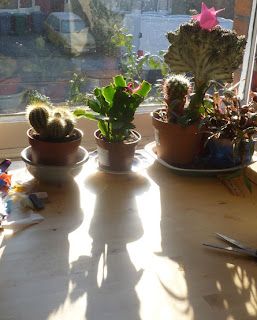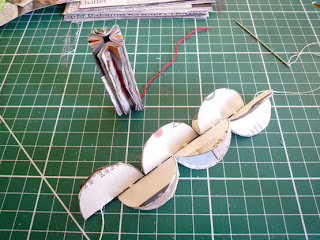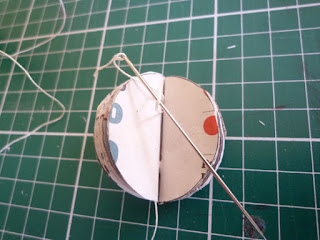With the sun streaming in on a frosty Sunday, it was a pleasure to sit in my "weekend studio" and work on books.
 The text project for reading week (last week) started with a visit to the "Medicine Man" exhibit at the Wellcome Collection - with the task of finding three different objects that you feel can be related. On Friday I spent quite a while looking at objects and taking notes (not drawing...) and found myself drawn to amulets and reliquaries of various sorts - objects that offered the hope of protection - and speculating about the belief systems behind them in cultures without western medicine (which after all is basically another belief system). Magical instruments - and community rituals that validate and reinforce the belief about their efficacy.
The text project for reading week (last week) started with a visit to the "Medicine Man" exhibit at the Wellcome Collection - with the task of finding three different objects that you feel can be related. On Friday I spent quite a while looking at objects and taking notes (not drawing...) and found myself drawn to amulets and reliquaries of various sorts - objects that offered the hope of protection - and speculating about the belief systems behind them in cultures without western medicine (which after all is basically another belief system). Magical instruments - and community rituals that validate and reinforce the belief about their efficacy."Write continuously for three minutes in response to each of the objects" - on Sunday, looking at my notes I chose objects almost a random, but the three did have that commonality of being protective. "You might decide to change the normal way in which you write" - ok, let's try that ...
Then, find the parts of the writing you like and intend to continue to use. These words and phrases become objects in your visual-textual "gallery" - to be used on the page "in groups across a sequence of pages to hint at the network of relations that you identified when you began".
 Though I also wrote about a17th century amulet against Lilith and a Victorian lampoon of "universal vegetable pills", most of my words came from writing about a reliquary bundle from Gabon (in times of great danger everyone in the village would get out their reliquaries, containing bones from ancestors, to amplify the ancestors' protection).
Though I also wrote about a17th century amulet against Lilith and a Victorian lampoon of "universal vegetable pills", most of my words came from writing about a reliquary bundle from Gabon (in times of great danger everyone in the village would get out their reliquaries, containing bones from ancestors, to amplify the ancestors' protection).
 Though I also wrote about a17th century amulet against Lilith and a Victorian lampoon of "universal vegetable pills", most of my words came from writing about a reliquary bundle from Gabon (in times of great danger everyone in the village would get out their reliquaries, containing bones from ancestors, to amplify the ancestors' protection).
Though I also wrote about a17th century amulet against Lilith and a Victorian lampoon of "universal vegetable pills", most of my words came from writing about a reliquary bundle from Gabon (in times of great danger everyone in the village would get out their reliquaries, containing bones from ancestors, to amplify the ancestors' protection). I picked up some scraps of paper that were lying nearby - and the book wrote itself - which may or may not be a good thing! I'm not happy with the final page and will revisit the rest later, both in terms of the words used and their layout on the page. There are suggestions in the brief for websites dealing with visual, sound, and concrete poetry.
Part 2 of the project starts with choosing an object from the exhibition that suggests a potential book form. I'm using the "Goa stone" - an object I'd never heard of - bezoar (hairballs) considered so precious, so curative, that they were kept in elaborate containers -

This photo comes from here. Bezoar stone is a calcified concretion found in the stomachs of some animals, and was prized for its supposed medicinal properties as well as being believed to act as an antidote to poison. The scarcity of bezoar stones by the 17th century led a group of Portuguese Jesuits working in Goa to come up with a man-made version. These so called 'Goa Stones' were a mixture of bezoar as well as other precious objects believed to have curative powers (narwhal tusk, amethyst, ruby, emerald, coral and pearl), but mainly clay, silt, resin, shells, and musk. In an age before the birth of modern medicine the wealthy had absolute faith in their ability to ward off everything from assassination attempts to depression. Until the beginning of the 18th century, when medical authorities began to debunk the belief in these stones, they could sell for more then their weight in gold and were often contained in splendidly ornate cases.
I started with the idea of making a round book, out of newspaper (to reference the mud and other ordinary, unlovely things used to make the stones), and of cutting out some of the positive or commendatory words on the pages to decorate the case for the "stone". Cutting the newspaper into squares was a revelation - I wanted text, or at least black-and-white, both sides, but found very few of the squares worked that way - indeed most had neither text nor black-and-white; rather, they had coloured advertisements.
The folded edge, cut off, looked promising - it sewed together into a chunky 3D shape - so I cut circles out of the other folded edges, punched a couple of holes in each, and set to make a (5cm) "round book" - which had an interesting transitional phase -
 before a little reconfiguration, and some needleweaving, made it into a ball. (In fact it could easily be a xmas ornament!)
before a little reconfiguration, and some needleweaving, made it into a ball. (In fact it could easily be a xmas ornament!) The rest of the task for part 2 is to produce a text that could be stored in the chosen form. Part of my "form" would be the case for the "stone" ... I'm not sure whether the ball would contain the text, or the case would be the surface for the text. There are many possibilities - and we are to "try to find a way of combining words and phrases from your found material alongside and within your own text." When developing the book form, we are asked to consider how the use of materials would change the use of text, and whether the text produced could/should be edited in light of this.
The rest of the task for part 2 is to produce a text that could be stored in the chosen form. Part of my "form" would be the case for the "stone" ... I'm not sure whether the ball would contain the text, or the case would be the surface for the text. There are many possibilities - and we are to "try to find a way of combining words and phrases from your found material alongside and within your own text." When developing the book form, we are asked to consider how the use of materials would change the use of text, and whether the text produced could/should be edited in light of this.Some writers to research (most are new to me) are Gertrude Stein; John Cage, Jackson Mac Low (I'm glad to find his 9 Light Poems), Hannah Weiner (inventor of a new form that she called large-sheet poetry); Ronald Johnson ("ARK" took him 20 years to write, but he made a modest living writing cookbooks); William Burroughs and Brian Gysin (both part of the "Tangier Beats"); Kenny Goldsmith (creator of UbuWeb); Kristin Prevallet (poems made from found fragments, news stories, etc); Theresa Hak Kyung Cha (video works that use performance and text to explore interactions of language, meaning, and memory); Juliana Spahr; Susan Howe. The links here are the result of very brief research - there's lots to come back to.

















































